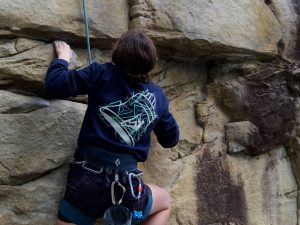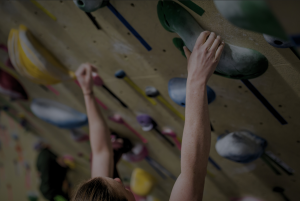Despite being the best starting point for learning dynos, the basic double dyno is actually a very uncommon move on an actual boulder problem or route. Why? It is very rare to throw with both hands. Typically, when the handholds are close enough to keep your feet on, a deadpoint or a single dyno will do nicely.
All Points Off
In extreme cases where handholds are far apart, double dynos can become necessary. This also requires you to give up your feet. An “all points off” double dyno is one of the most extreme forms of climbing moves.
However, once learned, it’s a great way to impress your friends! It is performed identically to what we described above. At the end of the move, your feet will leave their footholds. This allows you to literally jump for your next hold with both hands. Think of it almost like a basketball player making a slam dunk.
Why Should You Practice This Technique?
First, performing a double dyno will allow you to do certain moves that simply cannot be done any other way.
Second, it requires all of the skills necessary to do any dyno you happen upon. Master this dyno, and you’ve mastered them all!
Quick Tip
To develop the proper feel for this move, simply start moving your finish holds. Move them to a distance where you can’t keep your feet on the starting footholds when you grab them.
Once you have mastered the basic double dyno, move your finish progressively higher until you are required to “jump” to the holds. You will end up with your legs dangling in the air.
If you are having trouble with this modification, here are a few tips to keep in mind.
Good technique is everything!
One of the main reasons why climbers have trouble sticking longer dynos is because they do not pay enough attention to the mechanics of the move.
In order to get the greatest distance, you must get your hips as close as possible to the wall before you begin to push up. As we have discussed in another article, this is accomplished by arching your back and bringing your hips forward, while keeping your arms straight for as long as possible, to start the move.
If you do not get your hips in far enough, or let go or bend your arms too early, your hips will drift away from the wall as you jump. This causes you to come up short at the end of your throw.
Aim high!
The human brain is a marvelous thing. It’s capable of making thousands of precise calculations, unconsciously, every instant during climbing. Without that capability, we would be unable to walk, much less climb and do dynos.
But, it isn’t infallible.
One problem I see with climbers learning to dyno is that they tend to “aim” for the very edge of the hold they are throwing to. Maybe it’s because they are focused on what appears to be the shortest distance between the start and finish holds of a move.
This tendency, however, frequently leads to climbers coming up short on their dynos. They either miss the holds completely or have a too little surface area to stick the move.
To avoid this problem, climbers must develop the habit of overriding their impulse to “aim for the edge”. Instead, I recommend that in any dyno (and most deadpoints, for that matter) you aim about one inch above the hold you are throwing too.
This approach allows you to gain a bit of extra distance, and a bit of extra time to grab the holds exactly as you want to.
Hold on!
What if you’re following the first two tips above fastidiously, and you are still coming up short? The likely culprit is that you are letting go of your start hold too early.
As a rule of thumb, I recommend that climbers hold the start during a dyno until it feels like your upward momentum is pulling your hands off of the hold.
For visual reference, this will typically occur about the time your hands are at or slightly below your waist. The longer you hold on, the more of your momentum will be up the wall, as opposed to away from it. This translates directly into increased distance.
Follow these tips and you’ll be soaring through the air catching holds like a pro! And maybe impressing some people along the way. And make sure to check out the articles referenced in this one to differentiate between dynos and deadpointing, which is another great climbing technique.
All material is reprinted with the permission of the author. Copyright 2022 David H. Rowland. All rights reserved.









